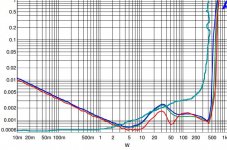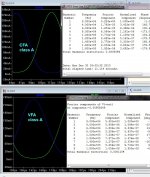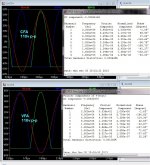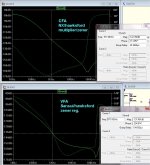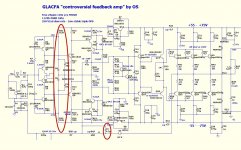I don't think so, why would a class AB designer want to cripple his designs with colored, non-transparent reproduction??
And a few (top notch) class D designers are already leaving class AB in the dust, class A soon as well....
Jan
Those "leaving class ab in the dust designs" won't make it to walmart. 😀
To the first comment , #1 ... look at the forum (the primary "trigger" for my remark) #2 . This is not MY goal. #3 . Some aspects of valves are desirable
(clipping behavior , THD "type") .. marketing hype ??
I know about some of the "audiophile" D amps (hypex) ,the Ncore has linear
amplifier techniques (nfb coverted to PW info).
Ncore whitepaper even states " as compared to the best LINEAR amplifiers" !
OS
Last edited:
The Devialet is a voltage modulated Class A amplifier with a Class D current on demand section.. a Hybrid, trying to pair quality with efficiency.
I have played it at a few Shows. I must say it's quite good. But so are the linear A-B amplifiers we also use a shows.
A good Valve Amp can sometimes have a magical way of conveying the emotions in the music. The best of them do have amazing qualities.
It's like all amplifiers have their own character. They play the music in different manner, some are bright an bold, some are grand, others slow cluttered and unfocused, others seem to be in a hurry. Few has this magic ability to transform the sound into music that really gets under your skin and urges you to dance and listen more. What creates what, is an endless puzzle with more questions than answers. I think that exactly whats so fascinating with this hobby. 🙂
I have played it at a few Shows. I must say it's quite good. But so are the linear A-B amplifiers we also use a shows.
A good Valve Amp can sometimes have a magical way of conveying the emotions in the music. The best of them do have amazing qualities.
It's like all amplifiers have their own character. They play the music in different manner, some are bright an bold, some are grand, others slow cluttered and unfocused, others seem to be in a hurry. Few has this magic ability to transform the sound into music that really gets under your skin and urges you to dance and listen more. What creates what, is an endless puzzle with more questions than answers. I think that exactly whats so fascinating with this hobby. 🙂
I can see why they do this, the Hypex Ncore "first watt" sucks.
Ncore versus a rough representation of either of my CFA creations -
(light blue drawn line).
The hypex does take the high power "crown" , it's thd drops lower to right
before it hits the rails.
I was thinking ... at 50W - 200w , most speakers are belting out 5-10%
THD ... who would notice PPM ?? 😕
OS
Ncore versus a rough representation of either of my CFA creations -
(light blue drawn line).
The hypex does take the high power "crown" , it's thd drops lower to right
before it hits the rails.
I was thinking ... at 50W - 200w , most speakers are belting out 5-10%
THD ... who would notice PPM ?? 😕
OS
Attachments
Made both of them NC400 and NC1200, good but nothing special, NC400 much better soundwise. The only thing I like about class D is SMPS. 😀
I can see why they do this, the Hypex Ncore "first watt" sucks.
Ncore versus a rough representation of either of my CFA creations -
(light blue drawn line).
OS
That looks like THD+Noise Vs. THD. Noise dominates most decent designs in the sub W region. Note to self...maybe noise is more important than THD at the levels I listen to these days 🙁.
Not to me. I know exactly what's going on, but that doesn't make it easier to achieve it in every situation - for the vast majority of people it's very much hit and miss ...It's like all amplifiers have their own character. They play the music in different manner, some are bright an bold, some are grand, others slow cluttered and unfocused, others seem to be in a hurry. Few has this magic ability to transform the sound into music that really gets under your skin and urges you to dance and listen more. What creates what, is an endless puzzle with more questions than answers. I think that exactly whats so fascinating with this hobby. 🙂
The reality is not that way at all, speakers have consistently been a convenient scapegoat in the audio game for sound subjectively not working - the distortion of speakers is of a type that doesn't get in the way of the musical message, it's the distortion of misbehaving electronics that will send everyone running to the exit door ...I was thinking ... at 50W - 200w , most speakers are belting out 5-10%
THD ... who would notice PPM ?? 😕
OS
Got to be said the electronics do seem to have a significant effect on sound. I have some KEF Coda 7s as test speakers. Up untill recently I have regarded them as "complete toilet". Always wondered how they got great reviews. Put it down to the right paper envelopes ending up in the right back pockets.
But now having been experimenting with this "CFA" idea they have come to life. Whether it is me matching the amp to the speaker is the reason why they now sound much better is immaterial. It does tend to suggest the character of the amp is still significant.
But now having been experimenting with this "CFA" idea they have come to life. Whether it is me matching the amp to the speaker is the reason why they now sound much better is immaterial. It does tend to suggest the character of the amp is still significant.
MiiB (3342)
A good Valve Amp can sometimes have a magical way of conveying the emotions in the music. The best of them do have amazing qualities.
It's like all amplifiers have their own character. They play the music in different manner, some are bright an bold, some are grand, others slow cluttered and unfocused, others seem to be in a hurry. Few has this magic ability to transform the sound into music that really gets under your skin and urges you to dance and listen more. What creates what, is an endless puzzle with more questions than answers. I think that exactly whats so fascinating with this hobby.
You are right. Good tube amps are impressive. But at the same time because of the large variation of parameters lamps is difficult to make a really good amplifier tubes. Many lamps except the microphone effect have reverb. This effect makes it difficult pairing lamps to increase the output power as the lamp chorus. Likely reverb effect lamps plays a major role in tube amplifiers and shapes their sound character.
Because of the increased harmonic spectrum, some amplifiers play all the music fun whether it's funny or tragic music, that is, can not convey the real emotion of music. This applies to both tube and transistor amplifiers to.
Best regards
Petr
A good Valve Amp can sometimes have a magical way of conveying the emotions in the music. The best of them do have amazing qualities.
It's like all amplifiers have their own character. They play the music in different manner, some are bright an bold, some are grand, others slow cluttered and unfocused, others seem to be in a hurry. Few has this magic ability to transform the sound into music that really gets under your skin and urges you to dance and listen more. What creates what, is an endless puzzle with more questions than answers. I think that exactly whats so fascinating with this hobby.
You are right. Good tube amps are impressive. But at the same time because of the large variation of parameters lamps is difficult to make a really good amplifier tubes. Many lamps except the microphone effect have reverb. This effect makes it difficult pairing lamps to increase the output power as the lamp chorus. Likely reverb effect lamps plays a major role in tube amplifiers and shapes their sound character.
Because of the increased harmonic spectrum, some amplifiers play all the music fun whether it's funny or tragic music, that is, can not convey the real emotion of music. This applies to both tube and transistor amplifiers to.
Best regards
Petr
A lot of people turn up an amplifier until they hear distortion and then back off a bit. When you have a high power GOOD clean high powered amp your speakers might be toast in a hurry.
The distortion they're hearing at this point is that of the amps, not the speakers. I have hammered speakers, mainly cheap ones, for years with amplifiers that deliver clean power all the way to clipping, and beyond, at volumes which are deafening on compressed types of material - and not have a speaker go funny on me. I'm not the type to have parties where people like to do dopey things with audio systems, nor to deliberately try and cook a voice coil - so long as the volume is not substantially above what one would hear in from real instruments, in a similar situation, I don't see a problem ...A lot of people turn up an amplifier until they hear distortion and then back off a bit. When you have a high power GOOD clean high powered amp your speakers might be toast in a hurry.
The "coming to life" is exactly what occurs when you drive the speaker properly; the recent hifi show I went to was full of expensive speakers sounding drab, dead, dreary, lifeless, not worth a cracker - for this very reason ...But now having been experimenting with this "CFA" idea they have come to life. Whether it is me matching the amp to the speaker is the reason why they now sound much better is immaterial. It does tend to suggest the character of the amp is still significant.
The "coming to life" is exactly what occurs when you drive the speaker properly; the recent hifi show I went to was full of expensive speakers sounding drab, dead, dreary, lifeless, not worth a cracker - for this very reason ...
So its not an uncommon observation...
My amp (now blown up due to experimentation - new version well on the way though) had low output impedance and well over 100W output. I only ever ran it at a couple of watts though. One comment was that "those little boxes have no right to be producing the sound they do".
The question is what is the definition (attributes) of driving a speaker correctly?
An underpowered amp will more likely make toast of good speakers.
The over- enthusiastic listener will more likely push it into distortion.
A trend I know by blowing many 😱.
Small amp blows tweeters - Large amp blows woofers (or both). 😀
OS
The over- enthusiastic listener will more likely push it into distortion.
A trend I know by blowing many 😱.
Small amp blows tweeters - Large amp blows woofers (or both). 😀
OS
Yes, that sort of experience can be repeated ad infinitum. My personal epiphany on this occurred decades ago, with very ordinary, bottom of the range B&W bookshelf units in my system - and then a few days later listening to monster, very expensive speakers in a dealer showroom, and having the latter sound quite pathetic in comparison ...One comment was that "those little boxes have no right to be producing the sound they do".
The question is what is the definition (attributes) of driving a speaker correctly?
It's easier to assess correct driving subjectively, but objectively the amplifier should be showing sufficiently low levels of distortion when driving the speaker in question, with music type signals, at the particular volume. Subjectively, an easy metric is to focus on the quality of relatively low level, high treble content while the amplifier is working relatively hard - rock with very constant striking of the cymbals makes it very easy, one can adjust the volume to precisely the point where the amp starts to audibly misbehave.
Last edited:
Pure distortion, or switching residuals ?Ncore versus a rough representation of either of my CFA creations -
Or the way they drive speakers ?it's the distortion of misbehaving electronics that will send everyone running to the exit door ...
Yes, it's the combination of amp and speaker that does the damage - at least, that's the way it is for me; no component is an island unto itself ...
Pure distortion, or switching residuals ?
Yes , the drawback of any AB amp.
At about 2-3W -switching starts ...
THD goes from single digit PPM to double digit almost immediately.
That is why I want the HK compound Vbe on my triple. THD rises
greatly under 35ma and over 100ma (OP stage bias).
It gets lowest at 65-70ma - I have always recommended this for NJWxxxx
devices.
In class A , my sansui/hawksford barely has 1-2ppm. If I ran that Genesis stealth
Class A OP stage with it - Nothing could "leave it in the dust" 😀
OS
Switching residuals....
We cannot "have it all".
After looking at the Ncore specs , I was curious about
typical DIYA VFA/CFA "first watt" performance.
In class A (below 1) ... performance is "halcro like"
I really "fine tuned" both my best CFA and VFA for these
tests. 🙂
Noise is in the nV range - "Badgers" (ksa992/ksc1845)are dead silent ,
Mpsa -XX's are even quieter.
For the next test -POWER - (below 2) ... I'm jealous of the Ncore, not bad here ...
but you can only realistically cancel "most" class AB distortion with NFB.
PSRR - Got the class D beat ... "better than 85db" 😀
I like 115 - 130db at least. (below 3)
Slew - CFA has VFA beat 2.5 to 1 (VFA 100v/us - CFA 250v/us).
Will this make an audible difference? ... I hope so !
Last , (below 4)the "Slewmaster" ... added 15V zener supplies for the diamond,
it will have cool looking 😎 UV and red LED's - visual impact !
This CFA matches or exceeds the sansui with much
simpler compensation.
Both amps are more "well behaved" than even the standard "blameless" ..
I expect NO issues with proper layout.
OS
We cannot "have it all".
After looking at the Ncore specs , I was curious about
typical DIYA VFA/CFA "first watt" performance.
In class A (below 1) ... performance is "halcro like"
I really "fine tuned" both my best CFA and VFA for these
tests. 🙂
Noise is in the nV range - "Badgers" (ksa992/ksc1845)are dead silent ,
Mpsa -XX's are even quieter.
For the next test -POWER - (below 2) ... I'm jealous of the Ncore, not bad here ...
but you can only realistically cancel "most" class AB distortion with NFB.
PSRR - Got the class D beat ... "better than 85db" 😀
I like 115 - 130db at least. (below 3)
Slew - CFA has VFA beat 2.5 to 1 (VFA 100v/us - CFA 250v/us).
Will this make an audible difference? ... I hope so !
Last , (below 4)the "Slewmaster" ... added 15V zener supplies for the diamond,
it will have cool looking 😎 UV and red LED's - visual impact !
This CFA matches or exceeds the sansui with much
simpler compensation.
Both amps are more "well behaved" than even the standard "blameless" ..
I expect NO issues with proper layout.
OS
Attachments
- Home
- Amplifiers
- Solid State
- CFA Topology Audio Amplifiers
